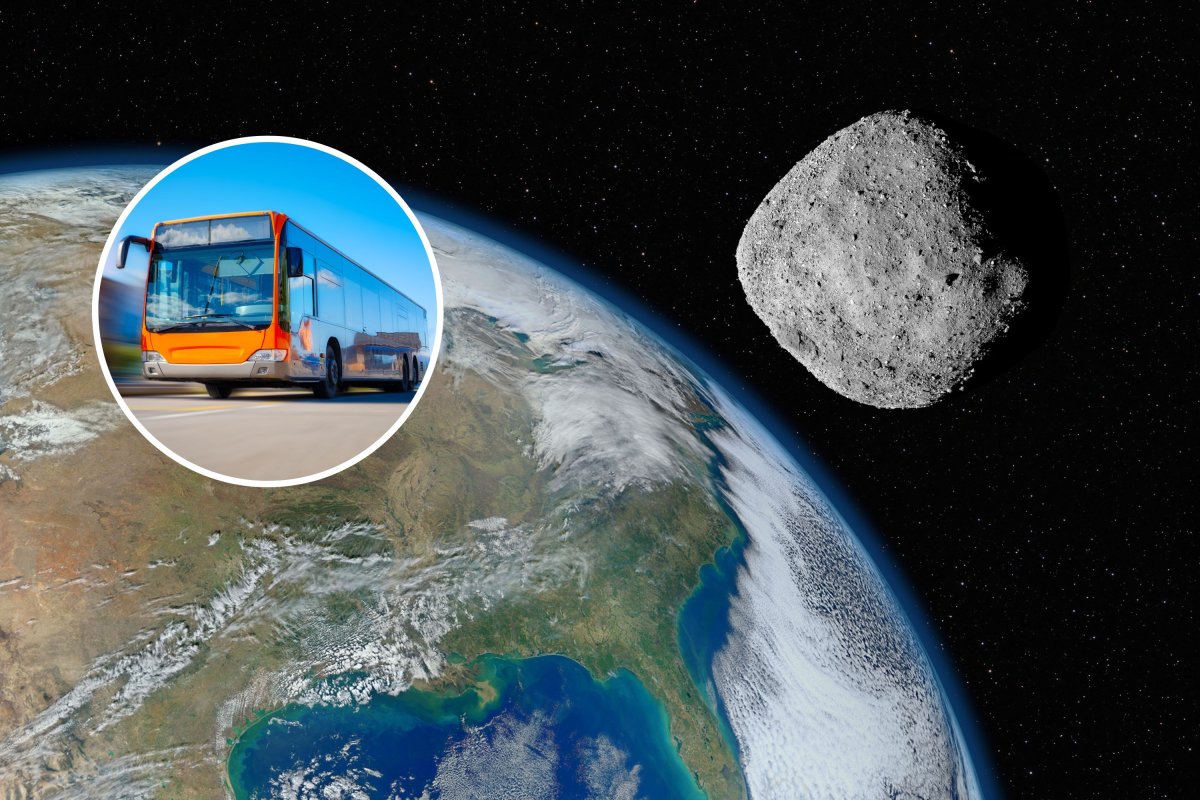A chunk of rock and ice about the same size as a bus is due to skim past the Earth on Monday. The asteroid, named (2024 UQ1), measures between 25.3 feet and 55.8 feet, according to NASA's Jet Propulsion Laboratory (JPL) Center for Near-Earth Object Studies (CNEOS), but is likely to be around 32 feet across. For reference, buses are usually between 35 and 45 feet long.
This asteroid is due to zoom past the Earth on October 28, passing us at a distance of about 148,000 miles, which is closer to our planet than the moon. This may sound like an immense distance, but on a space scale, this is very close: The moon orbits us at a much greater distance of 238,900 miles, and the sun is about 93 million miles away.

According to Jay Tate, director of the United Kingdom's Spaceguard Centre observatory, "Asteroids are 'bits of a planet that didn't happen' that orbit the Sun between Mars and Jupiter – the Main Asteroid Belt. However, as they are relatively small, asteroids have orbits that can be perturbed quite easily, so they can develop orbits that cross those of planets." There are four other larger asteroids expected to skim past our planet in the coming days, but none will come as close as (2024 UQ1).
Asteroids (2024 TB2) and (2007 UT3), both around the size of airplanes, will pass Earth on October 26 at distances of 731,000 miles and 4,200,000 miles, respectively. Another airplane-sized asteroid, (2016 BF1), is set to pass on October 27 at a distance of 2,460,000 miles. A much larger 500-foot asteroid named (2020 WG) is also forecast to pass us from 2,070,000 miles away on October 28.
Bus-sized (2024 UQ1), along with plane-sized (2024 TB2), (2007 UT3), and (2016 BF1), are all classified as Near-Earth Objects or NEOs by CNEOS. These objects are within 30 million miles of Earth, and there are over 30,000 such objects in our solar system.
“Asteroids and comets with a perihelion distance (closest to the Sun) less than 1.3 astronomical units (AU), or approximately 120 million miles, are called near-Earth objects—or NEOs,” explained Svetla Ben-Itzhak, an assistant professor at Johns Hopkins University. Some NEOs are considered potentially hazardous asteroids (PHAs) if they come within around 4.6 million miles of Earth and have a diameter of at least 460 feet.
A potentially hazardous asteroid (PHA) is one that intersects the Earth’s orbit around the Sun by less than 0.05 astronomical units (1 AU is the distance to the Sun), which is just over 4.5 million miles. It also needs to have an absolute brightness of 22.0 or less, meaning it could cause significant regional damage if it hit the Earth, according to Martin Barstow, a professor of astrophysics at the University of Leicester.
Not all NEOs are potentially hazardous, but all hazardous objects are NEOs. Due to its size, (2020 WG) is also considered a PHA. Despite these classifications, none of the upcoming asteroids are likely to collide with Earth, but if a PHA were to hit, it could be catastrophic for human civilization.
“Not all cosmic objects present a threat to Earth,” Ben-Itzhak warned. “If a cosmic body [of 460 feet (140 meters) in diameter] crashed into Earth, it could destroy an entire city and cause extreme regional devastation; larger objects over 1 kilometer [in diameter] could have global effects and even cause mass extinction.”
Do you have a tip on a science story that Newsweek should be covering? Do you have a question about asteroids? Let us know via science@newsweek.com.
You Might Also Like
Drivers In Hawaii Have The Worst Driving Habits, Tennessee Tops The List For Best BehaviorEmily VanCamp Returns To The Resident: What To Expect In Season 5 Finale
The New York Times' Connections: A Deep Dive Into The Trendy Puzzle Game
Simon Cowell: A Peek Into The Life Of The Iconic Judge And His Family
MAGA Firebrand Anna Paulina Luna Faces Tough Reelection Battle In Florida
Article Recommendations
- New Jersey Map Population Shifting Crowded 1975080
- What Pamela Anderson Has Said About Sex Tape Tommy Lee Pamela Love Story Netflix 1776828
- Tiffany Gomas Not Real Tiktok Video Ultra Right Beer Photo 1891657
- Mel Gibson Anti Semitism Racism Accusations 1512808
- Rainbow Bridge Closure What We Know 1846195
- Donald Trump Calls Jd Vance Town Hall Michigan 1974861
- Jonah Hill Sarah Brady Text Messages Full Transcript 1812193
- Joe Alwyn Posts Brooding Photo After Taylor Swift Cozies Travis Kelce 1950189
- Sweatpea Owner Speaks About Dog Honored During 2024 Puppy Bowl 1869279
- Little Rascals Netflix Where Are They Now 2021 1582862


